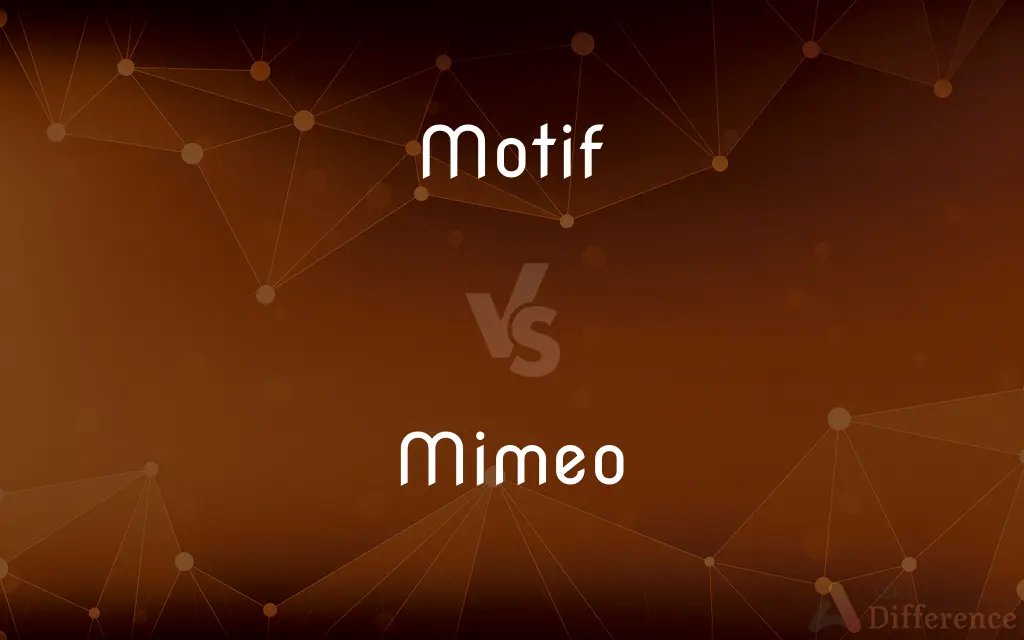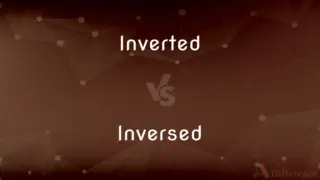Motif vs. Mimeo — What's the Difference?
By Tayyaba Rehman & Maham Liaqat — Updated on April 17, 2024
Motif refers to a recurring theme or element in art or literature, emphasizing consistency, whereas Mimeo, short for mimeograph, relates to an outdated duplicating machine using stencil technology.

Difference Between Motif and Mimeo
Table of Contents
ADVERTISEMENT
Key Differences
A motif in literature or art is a repeated element or theme that has symbolic significance, helping to reinforce the narrative's central message. On the other hand, a mimeo, or mimeograph, is a mechanical device once commonly used for making copies of printed materials via a stencil process.
Motifs are integral to the depth and cohesion of a story, often symbolizing broader concepts within a narrative. Whereas mimeographs were practical tools in offices and schools for duplicating text and images before the advent of modern digital printers.
The use of motifs can be diverse, ranging from visual repetitions in artwork to thematic recurrences in literature. In contrast, mimeo machines were specifically designed for document reproduction, utilizing ink pushed through a stencil onto paper.
Artists and writers carefully choose motifs to subtly influence the viewer's or reader's understanding and emotional response. On the other hand, mimeographs served a more straightforward, utilitarian purpose, facilitating communication by enabling the mass production of documents.
Comparison Chart
Definition
A recurring element with symbolic significance in art and literature.
A machine for copying documents using stencil technology.
ADVERTISEMENT
Usage
Used to add depth and cohesion to narratives.
Used for duplicating text and images in bulk.
Field
Common in literature, film, and visual arts.
Primarily used in education and office settings.
Purpose
To enhance thematic complexity and viewer/reader engagement.
To produce multiple copies of documents efficiently.
Technological Relevance
Remains conceptually relevant in contemporary creative works.
Largely obsolete due to digital printing technologies.
Compare with Definitions
Motif
A short succession of notes producing a single impression; a brief melodic or rhythmic formula out of which longer passages are developed.
The symphony introduces a haunting motif in its first movement that echoes in various forms throughout.
Mimeo
Relies on a manual process involving a drum coated with ink.
The mimeo drum had to be turned by hand, which required considerable effort for large batches.
Motif
A decorative design or pattern.
The pottery featured a green and blue floral motif around the rim.
Mimeo
Used historically for producing inexpensive copies of typed or handwritten documents.
They distributed the meeting agenda created on a mimeo to all attendees.
Motif
A recurring theme or element in a work of art or literature.
The motif of light and dark recurs throughout the novel to symbolize good and evil.
Mimeo
Considered outdated technology, replaced by modern digital printing and photocopying methods.
Most offices replaced mimeos with digital copiers because they are faster and produce better quality copies.
Motif
A distinctive feature or dominant idea in an artistic or literary composition.
The repeated motif of water in her paintings emphasizes renewal and fluidity.
Mimeo
A mimeograph, an early form of duplicating machine that works by forcing ink through a stencil onto paper.
The school newsletter was printed on a mimeo, giving it a distinctive purple ink.
Motif
An observable characteristic or behavior that recurs in a data set or experimental series.
Researchers identified a motif in the data indicating a predictable pattern of response among participants.
Mimeo
Often used in schools, small offices, and churches before the rise of digital printers.
Before the digital era, the church weekly bulletins were produced using a mimeo.
Motif
A recurrent thematic element in an artistic or literary work.
Mimeo
A mimeograph.
Motif
A dominant theme or central idea.
Mimeo
To mimeograph.
Motif
(Music) A short rhythmic or melodic passage that is repeated or evoked in various parts of a composition.
Mimeo
A mimeograph.
Motif
A repeated figure or design in architecture or decoration.
Mimeo
An unpublished academic paper.
Motif
A recurrent pattern either of molecular sequence, usually of nucleotides or amino acids in proteins, or of molecular structure that usually corresponds to specific biological activity.
Mimeo
To mimeograph.
Motif
A recurring or dominant element; an artistic theme.
See how the artist repeats the scroll motif throughout the work?
Mimeo
A mimeograph.
Motif
(music) A short melodic or lyrical passage that is repeated in several parts of a work.
Mimeo
To make copies of using a mimeograph.
Motif
A decorative figure that is repeated in a design or pattern.
Mimeo
A rotary duplicator that uses a stencil through which ink is pressed (trade mark Roneo)
Motif
(dressmaking) A decorative appliqué design or figure, as of lace or velvet, used in trimming.
Mimeo
Print copies from (a prepared stencil) using a mimeograph;
She mimeographed the syllabus
Motif
(crystallography) The physical object or objects repeated at each point of a lattice. Usually atoms or molecules.
Motif
(chess) A basic element of a move in terms of why the piece moves and how it supports the fulfilment of a stipulation.
Motif
(biochemistry) In a nucleotide or aminoacid sequence, pattern that is widespread and has, or is conjectured to have, a biological significance.
Motif
Motive.
Motif
In literature and the fine arts, a salient feature or element of a composition or work; esp., the theme, or central or dominant feature;
This motif, of old things lost, is a favorite one for the serious ballade.
The design . . . is . . . based on the peacock - a motif favored by decorative artists of all ages.
Motif
A decorative appliqué design or figure, as of lace or velvet, used in trimming; also, a repeated design.
Motif
A design that consists of recurring shapes or colors
Motif
A theme that is elaborated on in a piece of music
Motif
A unifying idea that is a recurrent element in a literary or artistic work;
It was the usual `boy gets girl' theme
Common Curiosities
How does the complexity of a motif affect a narrative?
The complexity of a motif can greatly enrich a narrative by adding layers of meaning that encourage deeper engagement and interpretation from the audience.
Can motifs appear in non-literary art forms?
Yes, motifs can appear in various art forms including visual arts, music, and film, serving similar symbolic or thematic purposes.
What are the limitations of mimeographs compared to modern printers?
Mimeographs are limited by their lower resolution, manual operation, and slower output compared to modern printers that offer high-quality, efficient, and automated printing.
What distinguishes a motif from a recurring character or setting?
A motif is a symbolic or thematic element, while a recurring character or setting is more directly related to the narrative structure and plot development.
What advancements replaced mimeographs?
Digital printing and photocopying technologies, which offer greater efficiency, flexibility, and quality, eventually replaced mimeographs.
What materials were necessary for operating a mimeo?
Operating a mimeo required a stencil, ink, and paper, as well as the mimeograph machine itself.
How did mimeographs impact educational settings historically?
Historically, mimeographs were crucial in educational settings for producing affordable and quick copies of teaching materials and exams, facilitating wider information distribution.
What were the environmental impacts of mimeographs?
The environmental impacts of mimeographs included the disposal of non-biodegradable stencils and the use of chemical-based inks.
Can a motif evolve throughout a narrative?
Yes, motifs can evolve throughout a narrative, reflecting changes in theme or the progression of the story.
Are motifs always intentional in creative works?
While motifs are often intentionally used by creators, they can also emerge unintentionally as a work develops, later becoming integral to the thematic fabric of the work.
Why did mimeographs often use purple ink?
Mimeographs often used purple ink because the aniline dye used in the stencil process was most effective and durable in this color.
How are motifs used in film?
In film, motifs are used visually and auditorily to reinforce themes, characterize relationships, and build emotional atmospheres.
What were common uses of mimeographs in offices?
Common uses of mimeographs in offices included duplicating documents like forms, memos, and flyers, especially before the availability of modern copiers.
How has the relevance of mimeographs in historical documentation changed?
The relevance of mimeographs in historical documentation has diminished with digital archival methods, but they remain a subject of study for understanding mid-20th-century technologies and office practices.
How can recognizing motifs enhance a reader's or viewer's experience?
Recognizing motifs can enhance the experience by deepening understanding of the narrative’s themes and appreciating the artistic craftsmanship involved.
Share Your Discovery

Previous Comparison
Javelin vs. Tip
Next Comparison
Inverted vs. InversedAuthor Spotlight
Written by
Tayyaba RehmanTayyaba Rehman is a distinguished writer, currently serving as a primary contributor to askdifference.com. As a researcher in semantics and etymology, Tayyaba's passion for the complexity of languages and their distinctions has found a perfect home on the platform. Tayyaba delves into the intricacies of language, distinguishing between commonly confused words and phrases, thereby providing clarity for readers worldwide.
Co-written by
Maham Liaqat














































